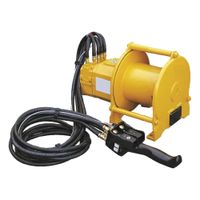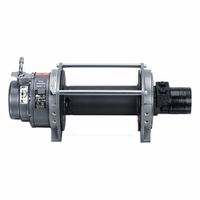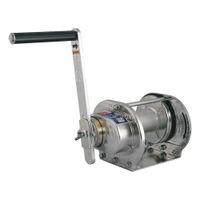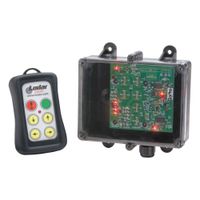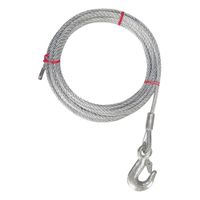Call +(254) 703 030 000 / 751 483 999 / 721 704 777
.....Read More
Frequently Asked Questions
What is the difference between a manual and an electric winch?
A manual winch and an electric winch differ primarily in their power source and operation.
A manual winch is operated by hand, typically using a crank or lever. It relies on human strength to wind the cable or rope around a drum to lift or pull a load. Manual winches are generally simpler in design, lighter, and more portable. They are ideal for smaller loads and situations where power sources are unavailable. They require more physical effort and time to operate, making them less suitable for frequent or heavy-duty tasks.
An electric winch, on the other hand, is powered by an electric motor, which can be connected to a vehicle's battery or an external power source. This type of winch is more efficient for lifting or pulling heavier loads with minimal physical effort. Electric winches are faster and more convenient, especially for repetitive tasks. They often come with remote controls, allowing for operation from a distance, enhancing safety and ease of use. However, they are typically heavier, more complex, and require a power source, which can limit their portability.
In summary, the choice between a manual and an electric winch depends on the specific needs of the task, including the load size, frequency of use, and availability of power sources.
How do I choose the right winch for my needs?
To choose the right winch, consider the following factors:
1. **Purpose**: Determine the primary use, such as vehicle recovery, industrial applications, or marine use.
2. **Weight Capacity**: Calculate the maximum load you need to pull. For vehicle recovery, a winch should have a capacity of 1.5 times the vehicle's gross weight.
3. **Winch Type**: Decide between electric, hydraulic, or manual winches. Electric winches are common for vehicles, hydraulic winches are powerful and used in industrial settings, and manual winches are suitable for lighter tasks.
4. **Line Speed**: Consider how quickly you need the winch to operate. Faster line speeds are beneficial for frequent use.
5. **Cable Type**: Choose between steel cable and synthetic rope. Steel is durable and abrasion-resistant, while synthetic is lighter and safer but requires more maintenance.
6. **Mounting Options**: Ensure compatibility with your vehicle or equipment. Options include bumper-mounted, multi-mount, or portable winches.
7. **Power Source**: For electric winches, ensure your vehicle's battery and alternator can support the winch's power requirements.
8. **Control Options**: Decide between wired or wireless remote controls based on convenience and safety needs.
9. **Durability and Weather Resistance**: Look for winches with weatherproofing features if used in harsh environments.
10. **Brand and Warranty**: Consider reputable brands with good customer support and warranty options.
11. **Budget**: Balance features with your budget, ensuring you get the necessary capabilities without overspending.
By evaluating these factors, you can select a winch that meets your specific requirements effectively.
What are the safety precautions when using a winch?
When using a winch, several safety precautions are essential to prevent accidents and ensure safe operation:
1. **Read the Manual**: Familiarize yourself with the manufacturer's instructions and guidelines specific to the winch model.
2. **Inspect Equipment**: Before use, check the winch, cable, and all components for damage, wear, or defects. Replace any damaged parts immediately.
3. **Use Appropriate Gear**: Wear gloves to protect your hands from cable burrs and eye protection to guard against flying debris.
4. **Secure the Vehicle**: Ensure the vehicle is in park or neutral with the parking brake engaged to prevent unintended movement.
5. **Anchor Properly**: Use a strong, stable anchor point. Ensure the anchor is capable of handling the load and is securely attached.
6. **Cable Management**: Keep the cable straight and avoid kinks. Use a winch dampener or blanket over the cable to reduce recoil in case of a break.
7. **Safe Distance**: Stand clear of the winch line and ensure bystanders are at a safe distance. Never straddle or step over a taut winch line.
8. **Control the Winch**: Use the remote control or switch from a safe distance. Never operate the winch with your body in line with the cable.
9. **Avoid Overloading**: Do not exceed the winch's rated capacity. Calculate the load and ensure it is within the winch's limits.
10. **Monitor Temperature**: Be aware of the winch motor temperature. Allow it to cool if it becomes too hot to prevent overheating.
11. **Communication**: Maintain clear communication with all involved in the winching operation to coordinate actions and ensure safety.
12. **Post-Use Inspection**: After use, inspect the winch and cable for any damage and perform necessary maintenance.
Following these precautions helps ensure safe and effective winch operation, minimizing the risk of injury or equipment damage.
How do I maintain and care for my winch?
To maintain and care for your winch, follow these steps:
1. **Regular Inspection**: Frequently check the winch for any signs of wear, damage, or corrosion. Pay special attention to the cable or rope, drum, and mounting bolts.
2. **Cleaning**: After each use, clean the winch to remove dirt, mud, and debris. Use a soft brush and mild detergent, then rinse with water. Ensure the winch is completely dry before storing.
3. **Lubrication**: Regularly lubricate moving parts such as the gears and drum bearings. Use a high-quality grease or oil recommended by the manufacturer to ensure smooth operation.
4. **Cable/Rope Maintenance**: Inspect the cable or synthetic rope for frays, kinks, or breaks. Replace if necessary. For steel cables, apply a light coat of lubricant to prevent rust. For synthetic ropes, wash with mild soap and water, then air dry.
5. **Electrical Connections**: Check the electrical connections for corrosion or looseness. Clean terminals and apply dielectric grease to prevent corrosion.
6. **Brake System**: Test the brake system periodically to ensure it engages and releases properly. Refer to the manufacturer’s guidelines for specific maintenance procedures.
7. **Control System**: Inspect the remote control and wiring for damage. Replace any faulty components to ensure reliable operation.
8. **Storage**: When not in use, cover the winch with a protective cover to shield it from the elements. Store in a dry, cool place if possible.
9. **Operational Testing**: Regularly test the winch under load to ensure it functions correctly. This helps identify potential issues before they become serious problems.
10. **Follow Manufacturer’s Guidelines**: Always adhere to the maintenance schedule and guidelines provided by the winch manufacturer for optimal performance and longevity.
What is the best type of winch for off-road use?
The best type of winch for off-road use is typically an electric winch. Electric winches are favored for their ease of use, reliability, and versatility. They are powered by the vehicle's battery, making them convenient and ready to use without the need for additional power sources. This is particularly advantageous in off-road situations where quick and efficient recovery is essential.
When selecting an electric winch for off-road use, consider the following features:
1. **Pulling Capacity**: Choose a winch with a pulling capacity of at least 1.5 times the gross vehicle weight. This ensures it can handle the weight of the vehicle in challenging conditions.
2. **Synthetic Rope vs. Steel Cable**: Synthetic ropes are lighter, safer, and easier to handle than steel cables. They are less likely to snap back dangerously if they break. However, steel cables are more durable in abrasive environments.
3. **Waterproofing**: Off-road conditions often involve water, mud, and dust. A winch with a high IP rating (e.g., IP67 or IP68) ensures it is well-protected against these elements.
4. **Line Speed and Motor**: A winch with a faster line speed and a powerful motor can recover a vehicle more quickly, which is crucial in time-sensitive situations.
5. **Remote Control**: A wireless remote control allows for safer operation from a distance, keeping the operator out of harm's way.
6. **Mounting Options**: Ensure the winch can be securely mounted to your vehicle's bumper or winch plate.
Brands like Warn, Smittybilt, and Superwinch are popular choices among off-road enthusiasts due to their reputation for durability and performance. Ultimately, the best winch is one that matches your specific vehicle requirements and off-road needs.
How do I install a winch on my vehicle?
1. **Select the Right Winch**: Choose a winch suitable for your vehicle's weight and intended use. Ensure it has the appropriate pulling capacity.
2. **Gather Tools and Materials**: You'll need a winch, mounting plate, bolts, nuts, washers, a socket set, wrenches, a drill, and possibly a wiring kit.
3. **Prepare the Vehicle**: Park on a flat surface, engage the parking brake, and disconnect the battery to ensure safety.
4. **Install the Mounting Plate**:
- Locate the mounting points on your vehicle's bumper or frame.
- Align the mounting plate with these points.
- Drill holes if necessary, ensuring they match the mounting plate.
- Secure the plate using bolts, nuts, and washers. Tighten them firmly.
5. **Mount the Winch**:
- Position the winch on the mounting plate.
- Align the winch's mounting holes with the plate.
- Insert bolts through the winch and plate, securing with nuts and washers.
- Tighten all bolts to ensure stability.
6. **Wire the Winch**:
- Connect the winch's power cables to the vehicle's battery. The positive cable goes to the positive terminal, and the negative to the negative terminal.
- Route the cables safely, avoiding sharp edges and heat sources.
- Use zip ties or clamps to secure the cables.
7. **Install the Control Switch**:
- Mount the control switch in a convenient location inside the vehicle.
- Connect the switch to the winch following the manufacturer's instructions.
8. **Test the Winch**:
- Reconnect the battery.
- Test the winch operation using the control switch, ensuring it pulls and releases smoothly.
9. **Final Check**:
- Inspect all connections and bolts.
- Ensure the winch is securely mounted and operational.
What are the advantages of using a hydraulic winch over other types?
1. **Power and Efficiency**: Hydraulic winches are known for their high power output and efficiency. They can handle heavy loads with ease, making them ideal for industrial applications and heavy-duty tasks.
2. **Continuous Operation**: Unlike electric winches, hydraulic winches can operate continuously without overheating. This makes them suitable for prolonged use in demanding environments.
3. **Variable Speed Control**: Hydraulic systems allow for precise control over the speed and torque, providing flexibility in operation. This is particularly useful in applications requiring delicate handling of loads.
4. **Durability and Reliability**: Hydraulic winches are robust and designed to withstand harsh conditions. They are less prone to wear and tear compared to electric winches, which can be affected by electrical issues.
5. **High Load Capacity**: These winches can handle significantly higher loads than electric or manual winches, making them suitable for heavy lifting and pulling tasks.
6. **Safety**: Hydraulic winches offer better control over the load, reducing the risk of accidents. They are equipped with safety features like load-holding valves that prevent the load from slipping.
7. **Versatility**: They can be used in a variety of applications, including marine, construction, and mining, due to their adaptability to different power sources and environments.
8. **Energy Efficiency**: Hydraulic systems can be more energy-efficient, especially in applications where the winch is used intermittently, as they do not consume power when not in use.
9. **Compact Design**: Despite their power, hydraulic winches can be designed to be compact, saving space and making them easier to integrate into existing systems.
10. **Low Maintenance**: With fewer moving parts and no electrical components, hydraulic winches generally require less maintenance, reducing downtime and operational costs.
